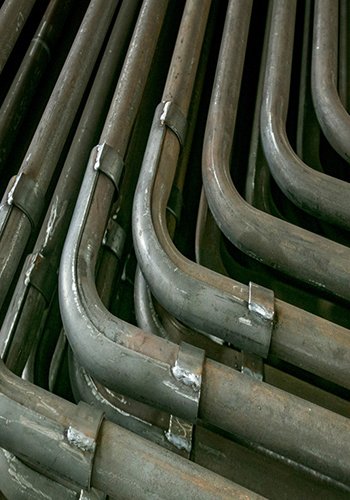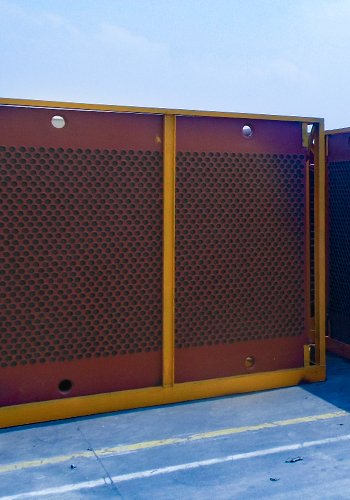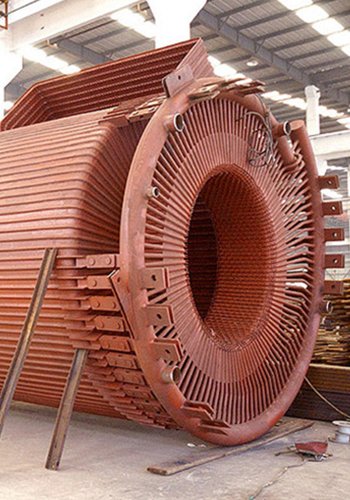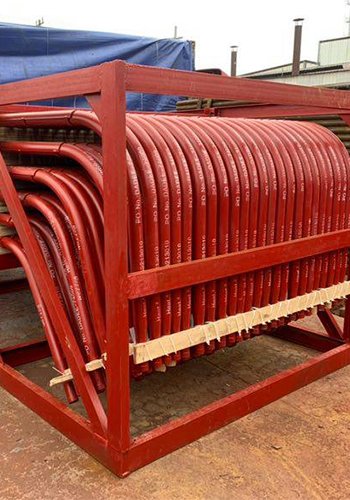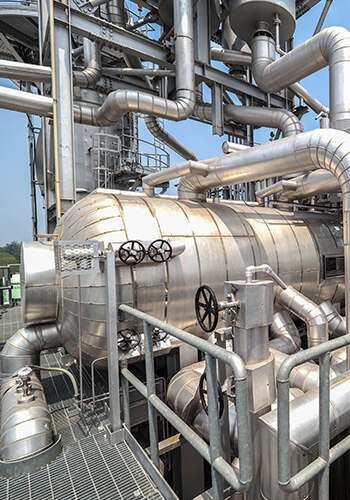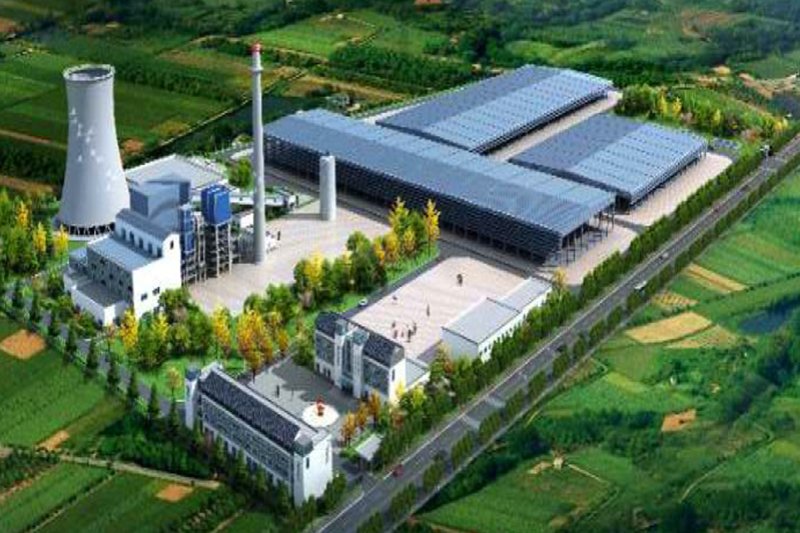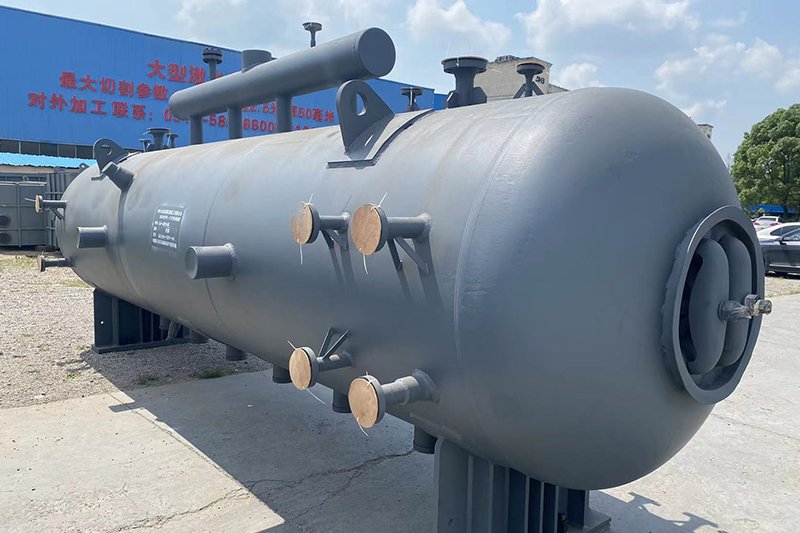Background
The #1 unit of a power plant is a 660 MW ultra-supercritical coal-fired unit. The boiler in use is a B&WB-2091/26.15-M model, designed and manufactured by Beijing Babcock & Wilcox Co., Ltd. It features a once-through intermediate reheating system with a single furnace and balanced ventilation. This outdoor-arrangement boiler employs a dry slag removal system, an all-steel frame, and an all-suspended structure. The burners are symmetrically arranged in an opposed configuration on the front and rear walls, each with three layers comprising a total of 36 burners. Additional NOx nozzles are located above the pulverized coal burners, contributing to reduced nitrogen oxide emissions.
The lower furnace features spiral water walls, while the upper furnace has vertical water walls. These water walls use a membrane-welding structure composed of steel pipes and flat steel, designed to withstand high temperatures and ensure efficient heat transfer. Despite its robust design, the boiler has encountered significant high-temperature corrosion issues, particularly on the side water walls near the burner area, which necessitated a comprehensive anti-corrosion spraying modification.
Problem Analysis
High-Temperature Corrosion Observations
Since 2020, inspections during three scheduled shutdowns revealed extensive high-temperature corrosion on the side water walls of the #1 unit’s furnace. The damage primarily manifested as severe cracking and peeling of the anti-corrosion coating in the burner area. This led to visible pitting corrosion and thinning of the pipe walls, with some areas falling below the minimum allowable thickness of 5.38 mm, as determined by strength calculations. Immediate repairs during each inspection cycle temporarily addressed the issue, but the damage recurred due to ongoing operational conditions.

Figure 1 Corrosion on the surface of side water wall tubes
Key findings include:
- Coking in burner and NOx nozzle areas: Coking caused severe stress on the coating and pipe surface, exposing the pipes to further corrosion.
- Material wear: Extensive corrosion and cracking in the anti-corrosion spray coating resulted in significant pipe wall thinning over time.
- Chemical composition analysis: Sampling revealed sulfur deposits in the corroded coating areas, a critical indicator of sulfide-related high-temperature corrosion.
Causes of Corrosion
- Coal Quality Variations: The sulfur content in the designed coal type (Huainan Panji coal) was 0.45%, with a softening temperature exceeding 1500°C. However, the current operational coal types often have higher sulfur content (up to 0.8% or more), lower melting points, and high alkali metal content, leading to slag formation and increased corrosion risks.
- Low-Nitrogen Combustion Techniques: To comply with environmental regulations, low-nitrogen burners were installed. These burners reduce NOx emissions by staging combustion, leading to oxygen-deficient zones near the upper burners and NOx nozzles. These oxygen-deficient zones create a reducing atmosphere, facilitating high-temperature sulfide corrosion.
- Water Wall Temperatures: The high outer wall temperatures of the water walls (521°C to 549°C under various load conditions) exacerbate corrosion. Low-load operations in recent years have further intensified these issues.
Anti-Corrosion Measures and Implementation
Membrane Replacement
Given the critical thinning of the side water wall tubes, a decision was made to replace the affected membrane areas entirely. The process included:
- Scope of Replacement: Both the A and B side walls required replacement of approximately 156 m² per side. This involved 272 tubes per side, spanning a height of 13,000 mm and a width of 12,000 mm. The extensive replacement ensured that all affected areas were addressed comprehensively, minimizing the risk of residual damage.
- Fabrication and Installation: Replacement membranes were pre-fabricated with a width not exceeding 400 mm for ease of transport through the furnace manhole. This modular approach allowed for greater flexibility during installation and reduced the potential for damage during transit. Flat steel welding was avoided near tube ends to facilitate precise on-site alignment and welding. This decision ensured that each membrane segment could be seamlessly integrated with the existing structure, enhancing the overall integrity of the repair.
- On-Site Construction: The on-site installation process was meticulously planned to ensure accuracy and safety. Tubes were carefully numbered and aligned using reference lines to maintain their original configuration. Plasma cutting technology was employed to achieve precision cuts, reducing the likelihood of errors during assembly. Scaffolding was erected to provide safe and efficient access to all installation areas, ensuring that workers could perform their tasks effectively. Additionally, binding straps, C-shaped supports, and small columns in the annular airbox were temporarily removed to facilitate membrane alignment and reinstalled after welding. This approach minimized disruptions to the existing structure and ensured a robust final installation.
Anti-Corrosion Spraying
A key part of the modification involved applying a PS45 anti-corrosion coating using the supersonic arc spraying technique.
- Spraying Material Characteristics:
- Composition: The PS45 coating contains 42%-45% chromium, 0.3%-1% titanium, and the balance in nickel. This composition ensures high corrosion resistance, wear resistance, and adhesion to the substrate.
- Advantages: The high chromium content forms dense chromium oxide layers, enhancing corrosion resistance. Nickel improves ductility and adhesion, while titanium strengthens the coating’s bond and aids in forming a uniform oxide layer.
- Spraying Process:
- Surface Pretreatment: The water wall tubes were cleaned and roughened using sandblasting to achieve a surface roughness of Rz30μm-120μm. This ensured optimal adhesion of the coating.
- Supersonic Arc Spraying: The spraying was conducted using a Laval nozzle to achieve particle velocities exceeding 420 m/s. This high-speed application resulted in a dense, uniform coating with a thickness of 300μm-400μm, porosity below 2%, and a hardness of HV450 or higher.
- Sealing Treatment: A high-temperature nano-ceramic sealing agent was applied to fill any residual porosity in the coating. This agent prevented corrosive substances from penetrating the coating and enhanced its durability.
- Quality Assurance:
- Coating Thickness: Measured using a thickness gauge to ensure consistency.
- Bonding Strength: Exceeded 50 MPa, meeting stringent operational requirements.
- Oxide Content and Porosity: Verified to ensure the coating’s integrity and performance under high-temperature conditions.
- On-Site and Workshop Spraying: While some membranes were sprayed in a controlled workshop environment, on-site spraying was performed for areas requiring final assembly. Special precautions were taken to prevent contamination of weld zones during installation.
Operational and Economic Benefits
The PS45 anti-corrosion spraying modification significantly improved the safety, reliability, and operational efficiency of the boiler, demonstrating clear advantages both technically and economically.
- Enhanced Corrosion Resistance: The dense, high-chromium coating provides exceptional resistance to high-temperature sulfide corrosion, a primary challenge in coal-fired boilers. By creating a robust protective barrier, the coating safeguards the water walls from aggressive chemical reactions and mechanical wear, even under severe operating conditions.
- Reduced Maintenance Costs: The application of the PS45 coating has substantially reduced the frequency of required maintenance and part replacements. Previously, recurring damage from corrosion necessitated frequent shutdowns for repairs, leading to increased operational costs and reduced availability. With the durable anti-corrosion layer, maintenance intervals have been extended, translating to significant cost savings and improved reliability for the plant.
- Improved Boiler Efficiency: Enhanced heat absorption is another key benefit of the modification. The uniform, high-quality coating facilitates better thermal conductivity while reducing the risk of slagging and coking on the water wall surfaces. These improvements not only optimize heat transfer but also help maintain stable combustion conditions, contributing to overall operational efficiency.
- Operational Stability: By addressing the underlying issues of corrosion and wear, the PS45 modification has enhanced the boiler’s operational stability. The reduced occurrence of unexpected failures has improved the predictability of plant operations, ensuring uninterrupted power generation and compliance with environmental standards.
In summary, the PS45 anti-corrosion spraying solution has delivered long-term reliability and efficiency improvements, reinforcing the operational resilience of the power plant’s critical boiler systems.
Future Recommendations
To maximize the longevity and performance of the anti-corrosion measures, several strategies and detailed steps should be implemented:
Sealing Maintenance: Conduct regular inspections of the ceramic sealing agent applied over the anti-corrosion coatings. Use thermal imaging cameras to identify any breaches or degradation in the sealing layer. Promptly reapply or repair the ceramic coating in affected areas to prevent corrosive agents from penetrating the protective barrier. Additionally, evaluate the performance of newly developed sealing materials that may offer superior durability and adhesion properties
Regular Monitoring: Establish a systematic inspection schedule to track the water wall thickness and detect corrosion indicators early. Use advanced non-destructive testing (NDT) techniques such as ultrasonic thickness gauging and radiographic inspection to ensure precise measurements. Document the findings to monitor trends over time, which can aid in predicting potential failure points and scheduling timely interventions.
Combustion Optimization: Develop and implement combustion strategies that minimize the formation of reducing atmospheres in the vicinity of the water walls. Employ advanced combustion control systems to monitor oxygen levels and combustion temperatures continuously. Regularly calibrate burners and NOx nozzles to maintain optimal fuel-air ratios, ensuring even combustion. Training for operators on best practices in combustion management can also help reduce localized hotspots that exacerbate corrosion.
Coal Quality Management: While sourcing high-quality coal with lower sulfur content may be challenging due to cost and supply constraints, blending lower-quality coal with additives that neutralize corrosive compounds can be a viable alternative. Additionally, invest in advanced coal preparation and cleaning techniques to remove impurities before combustion. Adopting real-time coal quality monitoring systems can also provide actionable data to adjust operational parameters and mitigate corrosion risks.
Conclusion
The anti-corrosion spraying modification of the #1 unit’s side water walls has proven to be an effective solution to address high-temperature corrosion. By leveraging advanced materials and techniques such as PS45 supersonic arc spraying, the modification ensures enhanced durability, reduced maintenance costs, and improved operational stability. Continued monitoring and optimization will be essential to sustain these benefits and support the long-term efficiency of the boiler system.
